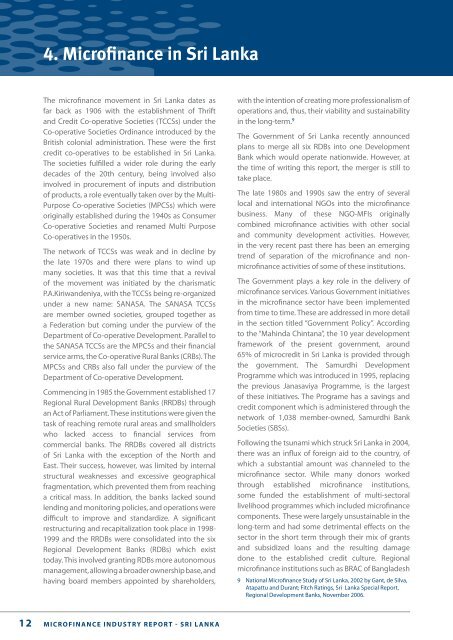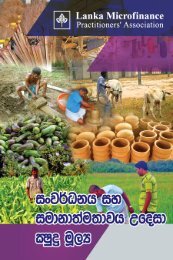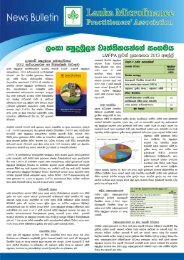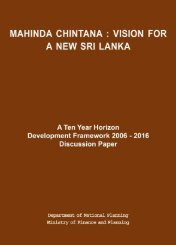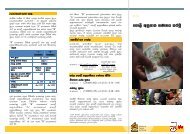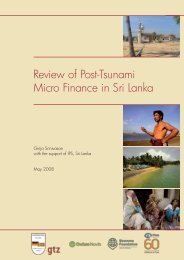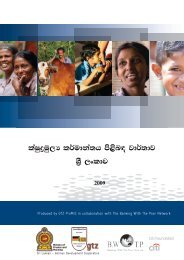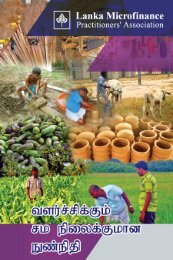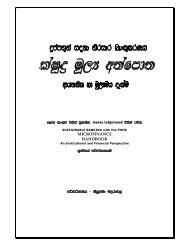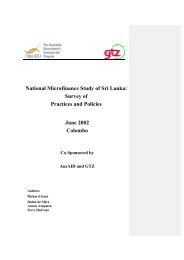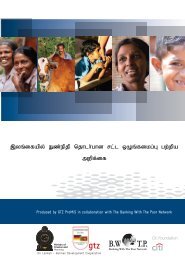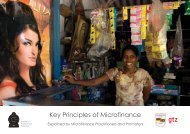Microfinance Industry Report SRI LANKA - Microfinance in Sri Lanka
Microfinance Industry Report SRI LANKA - Microfinance in Sri Lanka
Microfinance Industry Report SRI LANKA - Microfinance in Sri Lanka
You also want an ePaper? Increase the reach of your titles
YUMPU automatically turns print PDFs into web optimized ePapers that Google loves.
4. <strong>Microf<strong>in</strong>ance</strong> <strong>in</strong> <strong>Sri</strong> <strong>Lanka</strong><br />
The microf<strong>in</strong>ance movement <strong>in</strong> <strong>Sri</strong> <strong>Lanka</strong> dates as<br />
far back as 1906 with the establishment of Thrift<br />
and Credit Co-operative Societies (TCCSs) under the<br />
Co-operative Societies Ord<strong>in</strong>ance <strong>in</strong>troduced by the<br />
British colonial adm<strong>in</strong>istration. These were the first<br />
credit co-operatives to be established <strong>in</strong> <strong>Sri</strong> <strong>Lanka</strong>.<br />
The societies fulfilled a wider role dur<strong>in</strong>g the early<br />
decades of the 20th century, be<strong>in</strong>g <strong>in</strong>volved also<br />
<strong>in</strong>volved <strong>in</strong> procurement of <strong>in</strong>puts and distribution<br />
of products, a role eventually taken over by the Multi-<br />
Purpose Co-operative Societies (MPCSs) which were<br />
orig<strong>in</strong>ally established dur<strong>in</strong>g the 1940s as Consumer<br />
Co-operative Societies and renamed Multi Purpose<br />
Co-operatives <strong>in</strong> the 1950s.<br />
The network of TCCSs was weak and <strong>in</strong> decl<strong>in</strong>e by<br />
the late 1970s and there were plans to w<strong>in</strong>d up<br />
many societies. It was that this time that a revival<br />
of the movement was <strong>in</strong>itiated by the charismatic<br />
P.A.Kiriwandeniya, with the TCCSs be<strong>in</strong>g re-organized<br />
under a new name: SANASA. The SANASA TCCSs<br />
are member owned societies, grouped together as<br />
a Federation but com<strong>in</strong>g under the purview of the<br />
Department of Co-operative Development. Parallel to<br />
the SANASA TCCSs are the MPCSs and their f<strong>in</strong>ancial<br />
service arms, the Co-operative Rural Banks (CRBs). The<br />
MPCSs and CRBs also fall under the purview of the<br />
Department of Co-operative Development.<br />
Commenc<strong>in</strong>g <strong>in</strong> 1985 the Government established 17<br />
Regional Rural Development Banks (RRDBs) through<br />
an Act of Parliament. These <strong>in</strong>stitutions were given the<br />
task of reach<strong>in</strong>g remote rural areas and smallholders<br />
who lacked access to f<strong>in</strong>ancial services from<br />
commercial banks. The RRDBs covered all districts<br />
of <strong>Sri</strong> <strong>Lanka</strong> with the exception of the North and<br />
East. Their success, however, was limited by <strong>in</strong>ternal<br />
structural weaknesses and excessive geographical<br />
fragmentation, which prevented them from reach<strong>in</strong>g<br />
a critical mass. In addition, the banks lacked sound<br />
lend<strong>in</strong>g and monitor<strong>in</strong>g policies, and operations were<br />
difficult to improve and standardize. A significant<br />
restructur<strong>in</strong>g and recapitalization took place <strong>in</strong> 1998-<br />
1999 and the RRDBs were consolidated <strong>in</strong>to the six<br />
Regional Development Banks (RDBs) which exist<br />
today. This <strong>in</strong>volved grant<strong>in</strong>g RDBs more autonomous<br />
management, allow<strong>in</strong>g a broader ownership base, and<br />
hav<strong>in</strong>g board members appo<strong>in</strong>ted by shareholders,<br />
with the <strong>in</strong>tention of creat<strong>in</strong>g more professionalism of<br />
operations and, thus, their viability and susta<strong>in</strong>ability<br />
<strong>in</strong> the long-term. 9<br />
The Government of <strong>Sri</strong> <strong>Lanka</strong> recently announced<br />
plans to merge all six RDBs <strong>in</strong>to one Development<br />
Bank which would operate nationwide. However, at<br />
the time of writ<strong>in</strong>g this report, the merger is still to<br />
take place.<br />
The late 1980s and 1990s saw the entry of several<br />
local and <strong>in</strong>ternational NGOs <strong>in</strong>to the microf<strong>in</strong>ance<br />
bus<strong>in</strong>ess. Many of these NGO-MFIs orig<strong>in</strong>ally<br />
comb<strong>in</strong>ed microf<strong>in</strong>ance activities with other social<br />
and community development activities. However,<br />
<strong>in</strong> the very recent past there has been an emerg<strong>in</strong>g<br />
trend of separation of the microf<strong>in</strong>ance and nonmicrof<strong>in</strong>ance<br />
activities of some of these <strong>in</strong>stitutions.<br />
The Government plays a key role <strong>in</strong> the delivery of<br />
microf<strong>in</strong>ance services. Various Government <strong>in</strong>itiatives<br />
<strong>in</strong> the microf<strong>in</strong>ance sector have been implemented<br />
from time to time. These are addressed <strong>in</strong> more detail<br />
<strong>in</strong> the section titled “Government Policy”. Accord<strong>in</strong>g<br />
to the “Mah<strong>in</strong>da Ch<strong>in</strong>tana”, the 10 year development<br />
framework of the present government, around<br />
65% of microcredit <strong>in</strong> <strong>Sri</strong> <strong>Lanka</strong> is provided through<br />
the government. The Samurdhi Development<br />
Programme which was <strong>in</strong>troduced <strong>in</strong> 1995, replac<strong>in</strong>g<br />
the previous Janasaviya Programme, is the largest<br />
of these <strong>in</strong>itiatives. The Programe has a sav<strong>in</strong>gs and<br />
credit component which is adm<strong>in</strong>istered through the<br />
network of 1,038 member-owned, Samurdhi Bank<br />
Societies (SBSs).<br />
Follow<strong>in</strong>g the tsunami which struck <strong>Sri</strong> <strong>Lanka</strong> <strong>in</strong> 2004,<br />
there was an <strong>in</strong>flux of foreign aid to the country, of<br />
which a substantial amount was channeled to the<br />
microf<strong>in</strong>ance sector. While many donors worked<br />
through established microf<strong>in</strong>ance <strong>in</strong>stitutions,<br />
some funded the establishment of multi-sectoral<br />
livelihood programmes which <strong>in</strong>cluded microf<strong>in</strong>ance<br />
components. These were largely unsusta<strong>in</strong>able <strong>in</strong> the<br />
long-term and had some detrimental effects on the<br />
sector <strong>in</strong> the short term through their mix of grants<br />
and subsidized loans and the result<strong>in</strong>g damage<br />
done to the established credit culture. Regional<br />
microf<strong>in</strong>ance <strong>in</strong>stitutions such as BRAC of Bangladesh<br />
9 National <strong>Microf<strong>in</strong>ance</strong> Study of <strong>Sri</strong> <strong>Lanka</strong>, 2002 by Gant, de Silva,<br />
Atapattu and Durant; Fitch Rat<strong>in</strong>gs, <strong>Sri</strong> <strong>Lanka</strong> Special <strong>Report</strong>,<br />
Regional Development Banks, November 2006.<br />
12 microf<strong>in</strong>ance <strong>in</strong>dustry report - <strong>SRI</strong> <strong>LANKA</strong>


